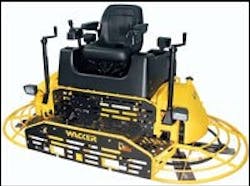Paving Report: Electronic-Steering System Eases Operator Fatigue
Among Wacker's 2004 World of Concrete introductions is the CRT-48-31V-ES—the industry's first concrete trowel with electronic steering, according to the company. Wacker hosted a group of editors at its Milwaukee headquarters to preview and operate the machine.
The trowel requires less effort to steer than to drive a car, according to product manager Russ Warner. When I sat in the comfortably padded operator's seat, I discovered exactly what he meant. Even for a first-time user, operation was easy and precise. My fingers rested on the two joysticks, similar to those on a skid-steer loader, and with only a slight nudge to the controls, the machine glided where I directed it.
Ease of operation, says Wacker, means that operators work with less fatigue. Adjustable steering-response capabilities, cup holders and toolboxes provide even more operator comfort, and the lighter plug can be used to charge phones.
Not only is the trowel ergonomic, it is lightweight, as well. The electronic machine weighs less than most competitive hydrostatic trowels, says the company. As a result, operators can place it on the slab quickly and get to work because the concrete will support it sooner, says Warner, which saves time and increases productivity. Also, the unit is light enough to be used on elevated deck pours. Fork pockets allow operators to raise and move the trowel to the desired level with a forklift.
Another benefit of being lightweight, says Wacker, is that the trowel uses less fuel, when compared to heavier hydrostatic- and mechanical-steering trowels. The CRT-48-31V-ES's 31-horsepower engine is smaller and lighter than competitive models, and fuel isn't used to work hydraulics, thanks to the machine's electronic steering capabilities. In addition, hydraulic-leak potential is minimized.
A variable-drive transmission provides broad speed range and allows the rotors to be timed in an overlapping position for finishing. Operators can change blade speed to match the condition of the concrete while maximizing engine torque—without mechanical adjustments or accessories.
The trowel's estimated list price is $24,000.
In addition to the CRT-48-31V-ES, Wacker will introduce the RT 56-SC and RT 82-SC "smart" trench rollers at World of Concrete in February.
Also easy to operate, the rollers feature a dual-joystick control box for steering. One joystick controls left/right movement, and the other controls forward/reverse movement.
The control system's infrared signal uses line-of-sight technology for safety. This was demonstrated in Milwaukee, when another editor stood between the machine and the remote to block the signal; the roller did not move. Also, if the operator comes within 3 feet of the front or rear sensing eye with the control box, the unit will stop moving and vibrating.
Another smart component, the Engine Control Module (ECM) determines if functions—engine oil pressure, radiator fluid level and engine temperature, among others—are working properly. If they aren't, the machine will automatically shut off. For ease of servicing, the rollers have removable fuel and hydraulic tanks, and all hydraulic connectors are located on the same side of the machine.
The RT 56-SC has a 22-inch-wide drum, and drum width on the RT 82-SC is 32 inches. Centrifugal force ranges from 7,000 to 14,000 pounds, and total applied force is 18,000 pounds.
